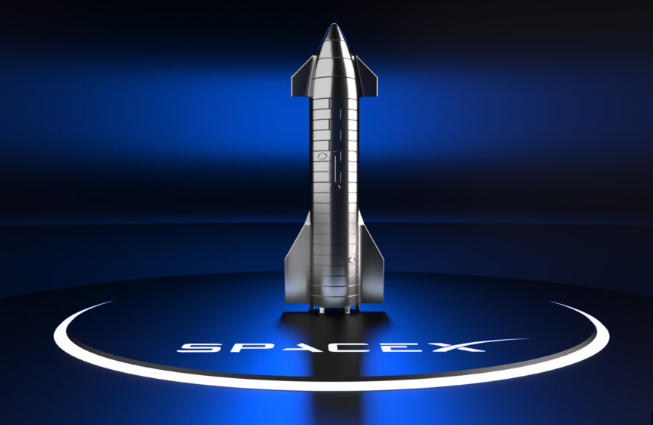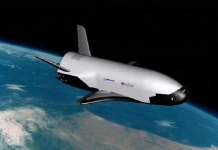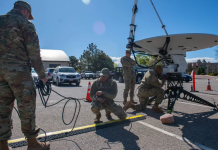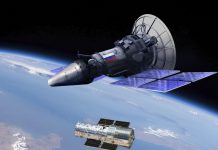The first half of 2023 saw Elon Musk launch his giant Starship/Super Heavy rocket, another commercial mission visit the International Space Station (ISS), Europe send a probe to explore Jupiter’s icy moons, one Virgin space company begin commercial service and another go belly up, and launch providers on three continents experience delays with their next-generation rockets.
The world is on a record pace with 97 launch attempts during the first six months of the year. At that pace, it’s likely that the space industry will collectively break last year’s record of 186 launch attempts.
Orbital Launches by Nation
January – June 2023
| Nation/Entity | Successes | Failures | Total | Percentage |
|---|---|---|---|---|
| United States | 49 | 4 | 53 | 54.6 |
| China | 25 | 0 | 25 | 25.8 |
| Russia | 9 | 0 | 9 | 9.3 |
| India | 4 | 0 | 4 | 4.1 |
| Japan | 1 | 1 | 2 | 2.1 |
| Europe | 1 | 0 | 1 | 1.0 |
| Israel | 1 | 0 | 1 | 1.0 |
| South Korea | 1 | 0 | 1 | 1.0 |
| North Korea | 0 | 1 | 1 | 1.0 |
| Total | 91 | 6 | 97 | 100 |
SpaceX accounted for 44 of the 97 launch attempts. That breaks down to one launch on average every 4 days, 2 hours, and 44 minutes. Twenty-two Falcon 9 launches were dedicated to deploying Starlink broadband satellites.
CEO Musk has said SpaceX is aiming to launch 100 times this year. To reach that total, the company will need to average one launch every 3 days, 6 hours, and 51 minutes during the second half of 2023.

A Launch to Remember
SpaceX’s massive Starship/Super Heavy launch vehicle lifted off for the first time, leaving a column of smoke and flames, on April 20 at 8:33 AM CDT. The blast of Super Heavy’s Raptor engines threw up large chunks of concrete from the launch pad and deposited debris over a wide area. A cloud of sand descended onto the city of Port Isabel more than six miles away.
As the rocket cleared the launch tower, it could be seen that three of the 33 Raptor engines had failed. Additional engines would fail one by one as the rocket continued skyward. Starship/Super Heavy passed through Max Q – the period of maximum dynamic pressure on the vehicle – but soon began to fly out of control and tumble. Starship couldn’t separate from Super Heavy, and the combined boosters exploded in a giant fireball less than four minutes after liftoff.
Musk, who defined success as the rocket clearing the tower, said he was satisfied with the flight. SpaceX is conducting a mishap investigation under the supervision of the Federal Aviation Administration (FAA). A new launch date can’t be set until the FAA approves the findings of the investigation and reviews any changes the company makes to the boosters.

Environmentalists were upset with the amount of debris the launch threw into the sensitive wildlife areas that surround the launch site. Following the launch, a coalition of environmental groups sued the FAA, claiming that the agency’s approval of SpaceX’s spaceport at Boca Chica Beach was in violation of the National Environmental Policy Act (NEPA). The plaintiffs want a new environmental impact statement done on the site, a process that could take years.
SpaceX has filed to join the lawsuit on the side of the FAA. The company is also constructing a new Starship/Super Heavy launch complex at NASA’s Kennedy Space Center in Florida.

Space Station Missions
The first half of 2023 saw two crews visit the ISS, and one crew visit China’s Tiangong station.
Russia launched the Soyuz MS-23 crew vehicle to ISS, with no one on board, on February 23. The spacecraft replaced Soyuz MS-22, which suffered a coolant leak that Russian officials blamed on a micrometeorite strike. Soyuz MS-23 will return to Earth later this year, with Soviet cosmonauts Sergey Prokopyev and Dmitry Petelin, and NASA astronaut Frank Rubio.
Space Station Missions
January – June 2023
| Date | Spacecraft | Destination | Crew |
|---|---|---|---|
| Feb. 9 | Progress MS-22 (83P) | ISS | None |
| Feb. 23 | Soyuz MS-23 | ISS | None |
| March 2 | Crew Dragon Endeavour (Crew-6) | ISS | Stephen Bowen Warren Hoburg Sultan Al Neyadi Andrey Fedyaev |
| March 15 | Cargo Dragon (CRS-27) | ISS | None |
| March 21 | Crew Dragon Freedom (Ax-2) | ISS | Peggy Whitson John Shoffner Ali AlQarni Rayyanah Barnawi |
| May 10 | Tianzhou-6 | Tiangong | None |
| May 24 | Progress MS-23 (84P) | ISS | None |
| May 30 | Shenzhou 16 | Tiangong | Jing Haipeng Zhu Yangzhu Gui Haichao |
| June 5 | Cargo Dragon (CRS-28) | ISS | None |
On March 2, SpaceX launched the Crew-6 mission to the space station with NASA astronauts Stephen Bown and Warren Hoburg, United Arab Emirates astronaut Sultan Al Neyadi, and Russian cosmonaut Andrey Fedyaev on board.
Al Neyadi is the second UAE astronaut to fly to the space station after Hazza Al Mansouri, who flew an eight-day mission aboard Russia’s Soyuz MS-15 spacecraft in September 2019. Al Neyadi will stay on the ISS for six months.
Crew-5, which consisted of American astronauts Nicole Mann and Josh Cassada, Japanese astronaut Kochi Wakata, and Russian cosmonaut Anna Kikina, returned to Earth on March 12, aboard Crew Dragon Endurance after more than 157 days in space.

On March 21, former NASA astronaut Peggy Whitson commanded Axiom Space’s second private mission to the ISS. Aboard the Crew Dragon Freedom for the 10-day flight were American Warren Hoburg and Saudi astronauts Rayyanah Barnawi and Ali AlQarni.
Barnawi, who is a biomedical researcher, became the first Saudi woman to fly to space. AlQarni is a captain in the Royal Saudi Air Force. Hoburg is an investor, pilot, and race car driver.
SpaceX and Roscosmos each launched two resupply missions to the space station during the first half of the year.
Tiangong Missions
On May 30, China launched Jing Haipeng, Zhu Yangzhu, and Gui Haichao aboard the Shenzhou-16 spacecraft for a six-month mission to the Tiangong space station.
The new astronauts replaced the Shenzhou-15 crew of Fei Junlong, Deng Qingming, and Zhang Lu, who returned to Earth on June 3 after 186 days in space.

Suborbital Flights
On June 29, Virgin Galactic conducted its first commercial mission with paying customers aboard when it flew Italian Air Force Col. Walter Villadei, Italian Air Force physician Lt. Col. Angelo Landolfi, and engineer Pantaleone Carlucci of the National Research Council of Italy on a suborbital research flight.
Virgin Galactic astronaut instructor Colin Bennett joined researchers in the passenger cabin on his second suborbital flight. Mike Masucci commanded VSS Unity, with Nicola Pecile serving as pilot.
The commercial flight followed the completion of VSS Unity‘s flight test program on May 25. Masucci and Frederick Sturckow commanded the flight with company employees Beth Moses, Luke Mays, Jamila Gilbert, and Christopher Huie in the passenger cabin.
Blue Origin announced it completed the mishap investigation into the in-flight abort suffered by New Shepard during an uncrewed research flight last September. The company said the booster failed due to the structural failure of the nozzle on the vehicle’s BE-3 engine. An escape rocket pulled the capsule safely away from the failing rocket. It landed safely under parachutes.
Blue Origin said it would soon resume flying both scientific experiments and paying customers to space. The company will begin by reflying the experiments that had been on the flight last September.
Launch Failures
Five of six launch vehicles making their maiden flights this year failed. Only Space Pioneer’s Tianlong-2 succeeded on its first flight.
Launch Vehicle Failures
January – June 2023
| Launch Vehicle | Owner/Operator | Nation | Launch No. |
|---|---|---|---|
| Chollima-1 | National Aerospace Development Administration | North Korea | 1 |
| H3 | JAXA | Japan | 1 |
| LauncherOne | Virgin Orbit | USA | 6 |
| RS1 | ABL Space Systems | USA | 1 |
| Starship/Super Heavy | SpaceX | USA | 1 |
| Terran 1 | Relativity Space | USA | 1 |
The failure of LauncherOne in January dealt a severe blow to Virgin Orbit, which had struggled for years with a low launch cadence and mounting financial losses. The company declared bankruptcy in April and later went out of business after auctioning off its assets to five bidders. None of the bidders was interested in continuing to fly LauncherOne.
The failure of Japan’s H3 booster in March resulted in the loss of the $250 million ALOS-3 Earth observation satellite. The failure of the rocket’s second stage caused the suspension of further flights of the H-IIA rocket, which uses a variant of the same engine.
Japan’s other launcher, Epsilon, has not flown since it suffered a failure on its sixth flight in October 2022.
Relativity Space retired its Terran 1 rocket after a single failed flight in order to focus on its larger Terran R booster. Terran 1’s first stage performed as planned, but the second stage failed to ignite.
Launcher Delayed
On April 14, an Ariane 5 launched ESA’s Jupiter Icy Moons Explorer (JUICE) mission, which will explore and study Ganymede, Callisto, and Europa. It will take the spacecraft eight years to reach Jupiter.
Ariane 5 will launch for the 117th and final time on July 4. The maiden flight of its successor, Ariane 6, has been pushed back to the end of this year or early next year due to a series of technical challenges.
Europe’s other launch vehicle, Vega-C, is still grounded after suffering a failure of its Zefiro 40 motor in December 2023. On August 29, the rocket’s manufacturer, Avio, announced that the booster’s return to flight would be further delayed due to an anomaly experienced during the test firing of a Zefiro 40 motor.
Avio said plans to launch the smaller Vega rocket in September remain on track because the booster does not use the Zefiro 40 motor.

United Launch Alliance (ULA) is continuing to experience delays with its new Vulcan Centaur rocket. The first slip came after unexpected variations in engine performance when two first-stage BE-4 engines were tested. Then a Centaur upper stage burst during testing, requiring reinforcement of a section of the stage.
Vulcan Centaur’s maiden flight has been pushed back to late this year. The rocket is designed to replace ULA’s Atlas V and Delta IV Heavy boosters.
Delta IV Heavy launched for the penultimate time on June 22. The booster’s final flight will be next year.
Source: parabolicarc.com







